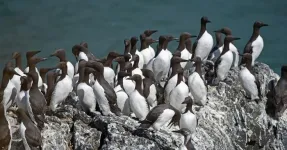(Press-News.org) As its 2024 Breakthrough of The Year, Science has named the development of lenacapavir – a promising new injectable drug that prevents HIV infection. The award also recognizes related work surrounding gaining a new understanding of the structure and function of HIV’s capsid protein. Despite decades of advancements, HIV continues to infect more than a million people annually, with a vaccine remaining elusive. However, a new injectable drug, lenacapavir, offers hope by providing six months of protection per shot. Clinical trials have demonstrated the drug’s remarkable efficacy, achieving 100% protection in African adolescent girls and women and 99.9% in gender-diverse groups across continents. Lenacapavir’s success stems from groundbreaking research on HIV’s capsid protein, which shields the virus's genetic material. By rigidifying this protein, the drug blocks key stages of viral replication. This capsid-targeting mechanism, once deemed impractical, could inspire treatments for other viral diseases. Initially developed as a rescue therapy for patients resistant to other drugs, lenacapavir’s long-lasting injectable form now positions it as a game-changer in HIV prevention. It overcomes adherence issues seen with daily oral pre-exposure prophylaxis (PrEP) and bimonthly injections like cabotegravir, particularly for populations facing stigma and access challenges. However, global rollout depends on affordability, manufacturing agreements, and robust health infrastructure, with regulatory approval expected by 2025. Nevertheless, its potential to drastically reduce infections in high-risk populations underscores its significance. Combined with previous biomedical advances, lenacapavir represents a pivotal step toward diminishing HIV/AIDS as a global health crisis.
END
Breakthrough of the Year: A drug that prevents HIV infection, providing six months of protection per shot
Summary author: Walter Beckwith
2024-12-12
ELSE PRESS RELEASES FROM THIS DATE:
Heatwave led to catastrophic and persistent loss of Alaska’s dominant seabird
2024-12-12
The 2014-2016 Pacific marine heatwave wiped out more than half – roughly 4 million – of Alaska’s common murre (Uria aalge) seabirds, representing the largest documented vertebrate die-off linked to warming oceans, according to a new study. “Although research on the impacts of global warming on marine birds has clearly suggested major shifts in species’ ranges and abundance, documented changes have been gradual (years to decades),” write the authors. “To our knowledge, this study is the first to show that climate impacts can be swift (1 ...
Genomic analysis refines timing of Neandertal admixture – and its impact on modern humans
2024-12-12
A genomic study encompassing more than 300 genomes spanning the last 50,000 years has revealed how a single wave of Neandertal gene flow into early modern humans left an indelible mark on human evolution. Among other findings, the study reports that modern humans acquired several Neanderthal genes that ended up being advantageous to our lineage, including those involved in skin pigmentation, immune response, and metabolism. To date, sequencing of Neanderthal and Denisovan genomes has revealed substantial gene flow between these archaic hominins ...
Superflares once per century
2024-12-12
There is no question that the Sun is a temperamental star, as alone this year’s unusually strong solar storms prove. Some of them led to remarkable auroras even at low latitudes. But can our star become even more furious? Evidence of the most violent solar “tantrums” can be found in prehistoric tree trunks and in samples of millennia-old glacial ice. However, from these indirect sources, the frequency of superflares cannot be determined. And direct measurements of the amount of radiation reaching the Earth from the Sun have only been available since the ...
A new timeline for Neanderthal interbreeding with modern humans
2024-12-12
A new analysis of DNA from ancient modern humans (Homo sapiens) in Europe and Asia has determined, more precisely than ever, the time period during which Neanderthals interbred with modern humans, starting about 50,500 years ago and lasting about 7,000 years — until Neanderthals began to disappear.
That interbreeding left Eurasians with many genes inherited from our Neanderthal ancestors, which in total make up between 1% and 2% of our genomes today.
The genome-based estimate is consistent with archeological evidence that modern humans and Neanderthals lived side-by-side in Eurasia for between 6,000 and 7,000 years. The analysis, which involved present-day human genomes ...
New timeline for Neandertal gene flow event
2024-12-12
The study of ancient DNA has greatly advanced our knowledge of human evolution, including the discovery of gene flow from Neandertals into the common ancestors of modern humans. Neandertals and modern humans diverged about 500,000 years ago, with Neandertals living in Eurasia for the past 300,000 years. Then, sometime around 40,000 to 60,000 years ago, modern human groups left Africa and spread across Eurasia, encountering Neandertals along the way. As a result, most non-Africans harbor one to two percent ...
Your immune cells are what they eat
2024-12-12
LA JOLLA (December 12, 2024)—The decision between scrambled eggs or an apple for breakfast probably won’t make or break your day. However, for your cells, a decision between similar microscopic nutrients could determine their entire identity. If and how nutrient preference impacts cell identity has been a longstanding mystery for scientists—until a team of Salk Institute immunologists revealed a novel framework for the complicated relationship between nutrition and cell identity.
The answers came while the researchers ...
Oldest modern human genomes sequenced
2024-12-12
After modern humans left Africa, they met and interbred with Neandertals, resulting in around two to three percent Neandertal DNA that can be found in the genomes of all people outside Africa today. However, little is known about the genetics of these first pioneers in Europe and the timing of the Neandertal admixture with non-Africans.
A key site in Europe is Zlatý kůň in Czechia, where a complete skull from a single individual who lived around 45,000 years ago was discovered and previously ...
Diverse virus populations coexist on single strains of gut bacteria
2024-12-12
Viruses that infect and kill bacteria, called phages, hold promise as new treatment types for dangerous infections, including strains that have become resistant to antibiotics. Yet, virologists know little about how phages persist in the populations of bacterial cells they infect, hampering the development of phage therapies.
Published online December 13 in the journal Science, a new study offers the first evidence that a single bacterial species, the host of a phage, can maintain a diverse community of competing phage species. Led by researchers at NYU Grossman ...
Surveys show full scale of massive die-off of common murres following the ‘warm blob’ in the Pacific Ocean
2024-12-12
Murres, a common seabird, look a little like flying penguins. These stout, tuxedo-styled birds dive and swim in the ocean to eat small fish and then fly back to islands or coastal cliffs where they nest in large colonies. But their hardy physiques disguise how vulnerable these birds are to changing ocean conditions.
A University of Washington citizen science program — which trains coastal residents to search local beaches and document dead birds — has contributed to a new study, led by federal scientists, documenting the devastating effect of warming waters on common murres in Alaska.
In 2020, participants of the UW-led Coastal ...
Floods, insufficient water, sinking river deltas: hydrologists map changing river landscapes across the globe
2024-12-12
AMHERST, Mass. — A new study in Science by researchers from the University of Massachusetts Amherst and University of Cincinnati has mapped 35 years of river changes on a global scale for the first time. The work has revealed that 44% of the largest, downstream rivers saw a decrease in how much water flows through them every year, while 17% of the smallest upstream rivers saw increases. These changes have implications for flooding, ecosystem disruption, hydropower development interference and insufficient freshwater supplies.
Previous attempts to quantify ...
LAST 30 PRESS RELEASES:
iPS cells from dish to freezer and back
Deep neural networks enable accurate pricing of American options under stochastic volatility
Collective risk resonance in Chinese stock sectors uncovered through higher-order network analysis
Does CPU impact systemic risk contributions of Chinese sectors? Evidence from mixed frequency methods with asymmetric tail long memory
General intelligence framework to predict virus adaptation based on a genome language model
Antibiotic resistance is ancient, ecological, and deeply connected to human activity, new review shows
Vapes, pouches, heated tobacco, shisha, cigarettes: nicotine in all forms is toxic to the heart and blood vessels
From powder to planet: University of Modena engineers forge a low-carbon future for advanced metal manufacturing
Super strain-resistant superconductors
Pre-school health programme does not improve children’s diet or physical activity, prompting call for policy changes, study finds
Autumn clock change linked to reduction in certain health conditions
AI images of doctors can exaggerate and reinforce existing stereotypes
Where medicine meets melody – how lullabies help babies and parents in intensive care
We may never be able to tell if AI becomes conscious, argues philosopher
AI video translation shows promise but humans still hold the edge
Deep ocean earthquakes drive Southern Ocean’s massive phytoplankton blooms, study finds
Without campus leftovers to pick through, the beaks of this bird changed shape during the pandemic
High-dose antibiotic does not reduce mortality in tuberculous meningitis
How many insects fly in the sky above the USA?
Could cheese protect your brain health?
Who faces more difficulty recovering from stroke?
Colliding galaxies create the brightest, fastest growing black holes at their center
New BrainHealth research reveals tradeoffs on sleep with cannabis use for chronic pain
Aging-US now on ResearchGate, enhancing visibility for authors and readers
'Molecular glue' stabilizes protein that inhibits development of non-small cell lung cancer
Mount Sinai Health System is recognized in 2025 Chime Digital Health Most Wired survey
From prey to predator: How carnivores spread beneficial fungi
Menopause symptoms may be frequent and have negative effects, according to female endurance athletes
US Congressmembers’ responses on X to mass shooting events differ along party lines
KAIST-UEL team develops “origami” airless wheel to explore lunar caves
[Press-News.org] Breakthrough of the Year: A drug that prevents HIV infection, providing six months of protection per shotSummary author: Walter Beckwith






